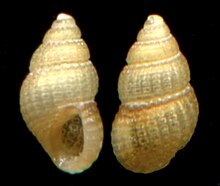|
Species of gastropod
| Alvania beanii
|

|
| Shell of Alvania beanii
|
Scientific classification 
|
| Domain:
|
Eukaryota
|
| Kingdom:
|
Animalia
|
| Phylum:
|
Mollusca
|
| Class:
|
Gastropoda
|
| Subclass:
|
Caenogastropoda
|
| Order:
|
Littorinimorpha
|
| Superfamily:
|
Rissooidea
|
| Family:
|
Rissoidae
|
| Genus:
|
Alvania
|
| Species:
|
A. beanii
|
| Binomial name
|
Alvania beanii
(Hanley in Thorpe, 1844)
|
| Synonyms
|
- Alvania (Turbona) beanii Thorpe, 1844
- Alvania beani [sic] (misspelling)
- Alvania beanii calathus (Forbes & Hanley, 1850)
- Alvania brocchii Weinkauff, 1868
- Alvania calathus (Forbes & Hanley, 1850)
- Alvania reticulata (Montagu, 1803)
- Alvania (Turbona) reticulata (Montagu, 1803)
- † Alvania tenuicostata L. Seguenza, 1903
- Cingula beanii Hanley, 1844
- Rissoa calathus Forbes & Hanley, 1850
- Rissoa textilis R. A. Philippi, 1844 junior subjective synonym
- Turbo reticulatus J. Adams, 1797 (invalid: junior homonym of Turbo reticulatus Solander, 1766)
- Turbo reticulatus Montagu, 1803
- Turbona calathus (Forbes & Hanley, 1850)
- Turbona cyrtoidea F. Nordsieck, 1972
|
Alvania beanii is a species of small sea snail, a marine gastropod mollusc or micromollusk in the family Rissoidae.[1]
Description
The length of the shell varies between 2.2 mm and 4 mm.
This broad shell has an oval-conical shape. It contains up to seven whorls and with deep sutures. The protoconch is multispiral. Its surface is reticulated by the close-packed ribs and the spiral cords (6 to 7 spiral cords on the body whorl above the aperture). The large aperture has an oval shape with a thick rim. The outer lip shows internal ridges and a well-developed varix. The inner lip is reflected over the umbilical region (but there is no umbilicus).
The color of the shell is white, cream or orange. There are often two brown bands on the body whorl.
Distribution
This species occurs in European waters, from the North Coast of Norway and the North East Atlantic Ocean down to the Canary Islands. It can also be found in the Mediterranean Sea (Corsica, Tunisia, Greece, Turkey).
Fossils have been found in Scaldisian (Pliocene) strata in Suffolk, Great Brittain; in Pleistocene strata in Belfast, Northern Ireland and Santa Flavia, Sicily.
References
- Nordsieck, F. (1972). Die europäischen Meeresschnecken (Opisthobranchia mit Pyramidellidae; Rissoacea). Vom Eismeer bis Kapverden, Mittelmeer und Schwarzes Meer. Gustav Fischer, Stuttgart. XIII + 327 pp.
External links
- Thorpe C. (1844). British marine conchology; Being a descriptive catalogue, arranged according to the Lamarckian system, of the salt water shells of Great Britain. London: Edward Lumley. l + 267 pp
- Forbes, E. & Hanley, S. C. (1848-1853). A history of British Mollusca and their shells. Vol. 1: i-lxxx
- Adams, J. (1797). XV. The Specific Characters of some minute Shells discovered on the Coast of Pembrokeshire, with an Account of a new marine Animal. Transactions of the Linnean Society of London. 3(1): 64-69, pl. 13
- Seguenza L. (1903). Rissoidi neogenici della provincia di Messina. Paleeontographica Italica. 9: 35-60, pl. 11
- Montagu, G. (1803). Testacea Britannica or natural history of British shells, marine, land, and fresh-water, including the most minute: Systematically arranged and embellished with figures. J. White, London, Vol. 1, xxxvii + 291 pp;; Vol. 2, pp. 293–606, pl. 1-16
- Philippi, R. A. (1844). Enumeratio molluscorum Siciliae cum viventium tum in tellure tertiaria fossilium, quae in itinere suo observavit. Vol. 2.. Halle (Halis Saxorum): Eduard Anton. iv + 303 pp., pls 13-28
- Weinkauff, H. C. (1868). Die Conchylien des Mittelmeeres, ihre Geographische und Geologische Verbreitung. Band II. Mollusca cephala. T. Fischer, Cassel. vi, 512 pp.
- Thanasis Manousis, The Marine Mollusca of Greece: an up-to-date, systematic catalogue, documented with bibliographic and pictorial references
- Glibert, M. (1962). Les Mesogastropoda fossiles du Cénozoïque étranger des collections de l'Institut Royal des Sciences Naturelles de Belgique. Première partie. Cyclophoridae à Stiliferidae (inclus). Institut Royal des Sciences naturelles de Belgiques, Mémoires. Deuxième série. 69: 1-305
|
